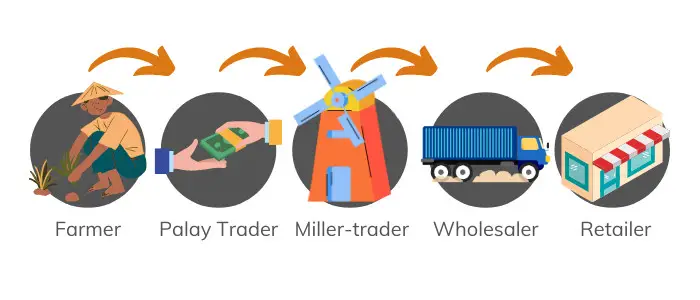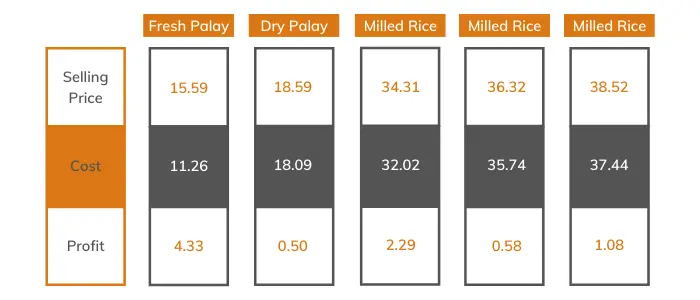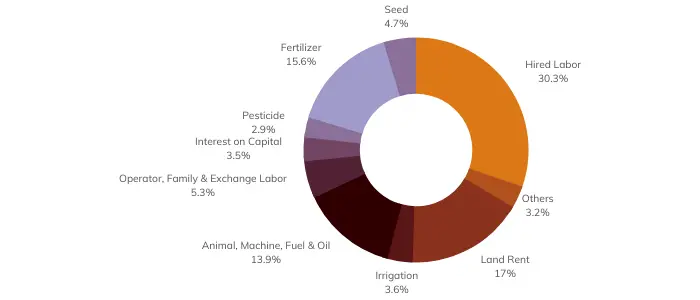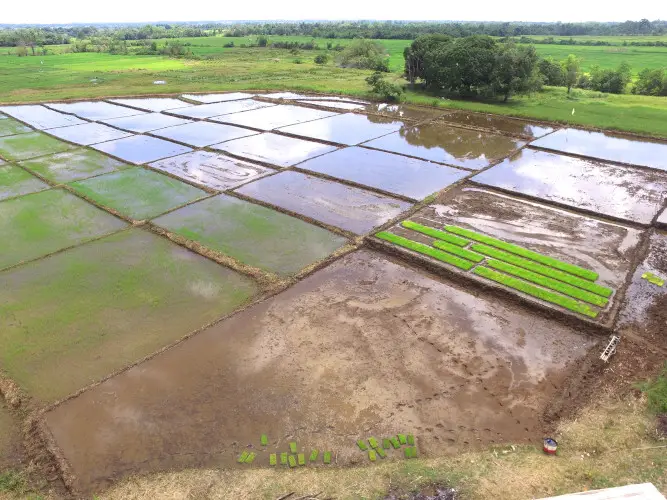I’ll try not to bore you with overused facts. You already know how rice is to Filipinos and that’s probably why you’re looking into how to start a rice business in the Philippines. I caught up with Bryan Dizon, my brother-in-law, farmer extraordinaire, and owner of Javenri Harvest Farm (“Javenri”), and asked the questions you may have on rice production and selling in our country. Though I suspect the lessons here apply to other countries, too.

Rice Paddies 
Javenri Harvest Farm
Page Contents
The Rice Value Chain and Players
When we say rice business or bigasan, the most common interpretation is that of a retailer or wholesaler. But there are several ways you can get into the industry. Here’s a list of your options as a business. We’ll also talk about the profit margins you might expect per business type.

All of the succeeding data are from the Philippine Statistics Authority (PSA) as presented by the Department of Agriculture (DA) in their training for trainers.
A lot of functions also overlap and may be carried out by a single player. For example, farmers may go directly to millers or even retailers. Skipping a few steps may mean more profit but also at the expense of more work.
Growers or farmers
The value chain starts with the farmers or growers. In terms of profit per kilogram, they have the highest at Php4.33/kg.
Keep in mind though that this is over the course of the entire process. That’s until harvesting or about 3 months in total. We’re not even mentioning the labor-intensive nature of a grower’s business.

Traders
Traders get the fresh unhusked rice (palay) and dry them ready for milling. As the middlemen between farmers and retailers, they’ve been given a bad rap for a few reasons (e.g., hoarding). But as long as farm-to-market roads are unavailable, traders have an important role to fill.
Wholesalers and retailers
For people who want to start, the most popular rice business option is selling because it is a straightforward process. You look for a good location, apply for the relevant business permits and licenses (BIR, DTI/SEC, NFA), buy the necessary equipment and assets, set up your management system, and so on.
What high demand means to you as a business
The good news is, demand for rice in the Philippines is high. As a country, we’re consistently in the Top 10 Rice Consumers in the World. Here’s the bad news: High demand doesn’t automatically imply large profits.
That’s a common misconception prevalent in the industry. I got this quote from one of the top results in Google.

Sorry, but NO! This approach fails to see the other side of the same coin, supply. If both supply and demand are high, then it’s a wash. There may even be billions or trillions of rice sacks demanded, but if supply is as widespread as demand, then that just means smaller margins for you, and potentially a losing business.
Let’s get back to the dealership example in the quote. If it’s that easy to enter the market as a dealer, then you’re most likely going up against entrepreneurs who want the same pie. The low barriers to entry mean more players, and ultimately smaller profits per dealer (and occasionally losses).
The point here being profit margins are dictated by more than just demand. There’s supply, which is partly determined by barriers to entry, and there are other economic factors to consider.
(Related: See Blue Ocean Strategy)
Understanding this is crucial when assessing the expected returns that follow.
Expected returns per business type
The expected profits mentioned in the following texts are also from the PSA, presented by the DA. The margins per business model are also presented in this table.

According to the dataset from the Philippine Statistics Authority:
1. Farmer (fresh palay) = 27.8%
2. Palay trader (dry palay) = 2.7%
3. Miller trader (milled rice) = 6.7%
4. Wholesaler (milled rice) = 1.6%
5. Retailer (milled rice) = 2.8%
Keep in mind that the returns are based on PSA’s sales and profit figures, and do not consider external economic and non-economic factors. That is, you may be getting less per kilogram as a trader, but also consider that it takes less effort and risk. When choosing a rice business type, capital, business plan complexity, and niche are also factors to think about. And of course, your risk tolerance and preferences should be taken into account.
Consider these tradeoffs when choosing a rice business model to pursue.
(Related: 3 Easy Steps to Assess Business Viability)
Movement towards Mechanization
In 2019, the Rice Tariffication law (RA 11203) was signed, allocating Php10 billion per year towards the mechanization, training, credit, and other initiatives for the betterment of the Philippine rice industry.
This has some implications for you as a business player in the rice industry.
One example is the potential for higher gains due to the mechanization, and lower overhead, of operations. This has been a contentious act though due to the lost jobs for farmers. But the idea, at least in economic theory, is they’ll eventually shift jobs to more productive uses. The change in work enhances the overall productivity of the economy.
It’s a short-term problem with a long-term gain.

Other aspects to take note of the excess tariff are financial assistance, land titling, crop insurance, farm diversification. The gist is this: We’re making strides to increase the competitiveness of the Philippine rice industry relative to our ASEAN neighbors. Riding this wave as an entrepreneur might not be a bad idea.
Conclusion
People wanting to start rice businesses in the Philippines should know that there are opportunities other than rice selling as retail or wholesale rice suppliers. Your 3 options are as a (1) grower/farmer, (2) trader, and (3) wholesaler/retailer.
PSA statistics are of great help, but keep in mind the economic tradeoffs per business model. Higher earnings usually come at the cost of more work and risks.
If you’re interested in starting a rice business, or maybe want to ramp up your existing rice production through training sessions and consultations, you may get in touch with Bryan at Javenri’s Facebook page. Javenri Harvest Farm is a certified training school in the Farmer Field School in Rice Production, a TESDA-sponsored training program.
Read more, select a topic:










